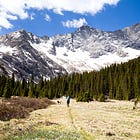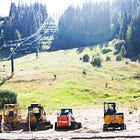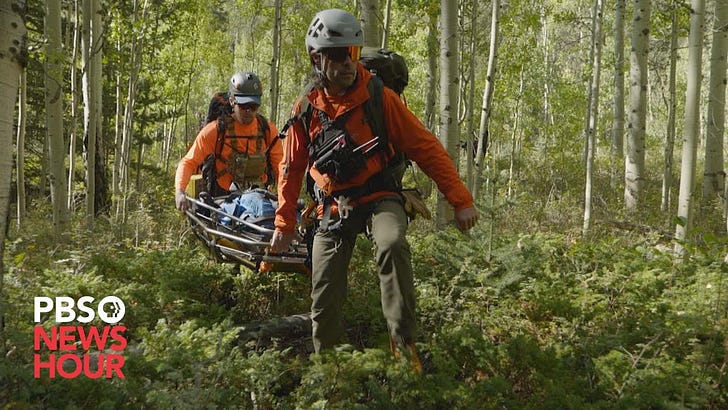Your mind and the outdoor industry's curated cognitive dissonance
Outdoor gear companies use marketing to carefully maintain myths that create cognitive dissonance in their customers' minds to sell more gear.
Posts on The Fleeting West are written and posted quickly and are often edited for clarity and quality later. For the best experience, see the copy on the website for the most up-to-date version.
For years, I have tried to reconcile my observations of the new wave of outdoor users and their apparent cognitive dissonance in their perception of themselves in outdoors spaces as noble contrarians to American consumerism. I have long known that there are two incompatible thoughts operating together in the minds of most of our newcomers in the West, and admittedly, some of our rooted residents, too. It took me years to identify the presenece of this dissonant mind virus in myself, and years of reflection to defray the very intentionally curated cognitive dissonance the outdoor gear industry has worked with surgical skill to embed in all of their messaging.
The outdoor gear industry has almost uniformly curated an image of their product lines as a solution to American consumerism — a solution to over-consumption of wasteful goods. By getting "closer to nature," you're invited onto a plane of better living. It’s as if all of your purchases are counter to the mindless consumerism of the masses you are so repulsed by; you’re cutting your carbon emissions by going for that hike, you're better for it, and you make the world a better place for being out there and away from the consumptive masses.
By going outdoors, you're leaving the material world behind and experiencing nature, which is transformative, rejuvenating, and part of a greater good. You're no longer lusting after cars, big boats, fashion, purses, bigger houses, jetskis, and industrial goods — you're lusting after nature and leaving consumerism behind. And you'll feel better and be better for it.

Interestingly, and on the contrary, every gear company from Patagonia to REI, Arc'teryx, Marmot, Smartwool, and pretty much all others, are actively participating in this marketing magic trick and they benefit from it in very big ways.
How contrary are your hiking boots to consumerism, really?
It's a fascinating act of mass-hypnosis to have an industry curate a myth that drives sales of their gear that makes people believe that what they're buying isn't consumerism, mass-consumerism, and is even antithetical to the perceived greed of mega corporations — like those you might find on a list of Fortune 500 companies. It's an easily disprovable lie, yet so many are unquestionably entangled in it.
If you look more deeply at what outdoor gear is made of, it becomes even more fascinating. The outdoor gear industry has curated a dense fleece over their market that lends to a belief that outdoor gear is also antithetical to the petroleum industry, fossil fuels, and even the automobile industry. Funny, because 99% or more of what companies like REI, Patagonia, Marmot, and all other outdoor gear makers manufacture and sell is entirely made from petroleum distillates. Hiking1, skiing2, bicycling, rock climbing, camping, and mountaineering are all petroleum sports.
If those claims seem outlandish, that's a first test for whether you're still influenced by these myths and a good checkpoint to take a moment to study and reflect. Every piece of outdoor gear you own is made entirely with a petroleum distillate, a mined material, and its presence in your hands is 100% a result of global shipping infrastructure and fossil fuels. And there is no exaggeration in those statements at all.
Outdoor gear, especially in the last two to three decades, has become one of the most lucrative industries on earth. The industry mass produces goods to the point of creating surpluses every year that get sold on clearance racks for bargain prices. There are even stores that entirely specialize in selling surplus goods that no longer have a place on the fashionable shelves of the major retailers. These big corporations go through mergers and are often mega-conglomerates that would make most of their fleeced consumers lose their noble little minds.
Think I'm wrong? Consider that Black Diamond's parent company is called "Clarus Corporation" and they own companies like Black Diamond, Sierra, PIEPS, and Rhino-Rack. How about V.F. Corporation that owns The North Face, Vans, and Timberland, and has a market cap in the billions of dollars? Maybe Columbia Sportswear, which owns previously independent companies like Mountain Hardwear, Prana, and Sorel, and pay shareholders dividends on profits of the company they can purchase and trade on national and international stock markets? There are very few non-corporate outdoor gear outfits today, and those few left are typically owned and operated by people who work a different day-job and run their shop on evenings and weekends.

It's pretty funny when you stop and think about it. The imagery these companies are curating is of you ... out in nature, away from it all, looking at pretty mountains, bettering yourself away from consumerism and the goods-hungry public their products are counter to … while selling you mass-produced, globally-sourced, profit-optimized goods. Yet the goods that allowed you go to from your comfortable urban loft in that little mountain town, Denver, to that ski slope out in nature, were made entirely possible by a mega-conglomerate that manufacturers millions of units per year and delivers profit reports to shareholders on Wall Street.
(The parts about "that little mountain town, Denver..." and “ski slopes in nature” are dripping with vitriolic sarcasm, in case it wasn't obvious.)
When outdoor gear merged with fashion, authenticity in the culture was lost.
There was a time when the outdoor gear industry had a more authentic bent against consumerism than it does today. Today, all of the outdoor gear manufacturers are using myths born from the roots of the industry to fleece customers into buying goods, guilt-free, for wild profit margins. But those myths were born from something, despite the culture being entirely lost on our newest generations of consumers.
The early days of the outdoor gear industry were pre-internet, pre-ivy-league-environmental studies degrees, and all happened before it was an urban trope to move to Colorado (ahem, Khala-raww-doeh, as the transplants say) to get closer to nature3.
In fact, the people of the east coast and areas of urban sophistications, thought those here doing things outside were quite insane. That is, if they even knew where Colorado was at all given that it was still called “flyover country” until the famous transplant, John Deutschendorf, Jr. (stage name, John Denver), put it on their mental map with his transplant anthems4.
Outdoor gear was often made in small shops in small towns in the interior West. Climbing gear was not an established industry yet. And, of course, the earliest climbers of peaks were all wearing wool, using cotton ropes, and sometimes, just risking it to see what was out there.
It's interesting to be born onto the precipice of where the change happened. It seems that the 1980s and ‘90s gave rise to a new group of people wanting to experience the outdoors, but were the first wave of pure followers of those who were truly innovative in this space.
Stories of people wearing climbing shoes on college campuses, and wearing expedition down coats to their college classes on cool days, and wearing Vaurnet glacier glasses as a fashion statement with their leather bomber jacket on their commutes to work, are all ones I've seen and heard from this time period5.
That inflection point is where the outdoor gear industry changed. It led small outdoor gear shops in small towns in the West to garner interest from investors and corporations. North Face was one of the first big companies to drive this change from fringe and artisan market to mass production and corporatization.
As soon as outdoor gear started to be used for identity peacocking in social spaces rather than as specialized tools to use to go take risks outside of the domestic domain, the foundation for today's outdoor gear mythmaking to sell more goods was solidified.

In that transition, outdoor gear started to be influenced by mindsets that make the fashion industry possible. The appearance of oneself in these costume pieces started to override the inherent functions. We then needed more variety of colors, shapes, and options. We needed more tchotchkes, more places to buy them, and more places to wear these new and fashionable things.
The outdoor industrial complex uses some incredibly well-made stage curtains to curate this highly profitable dissonance about what we’re doing when we buy outdoor gear and what happens after we close the door to our cars at the trailhead or ski resort parking lot and wander off into the wilds of the well-mapped-unknown6.
Highly profitable, curated cognitive dissonance, spared no expense.
Since more than three out of four people in Colorado today are not from Colorado or even the interior West, I get to have plenty of conversations about what brought people here and why. Despite the tone in most of my writings here, I'm friendly in my interactions — because I'm genuinely interested in what is driving so many people here so quickly, and I recognize that my war is best fought with information than with hand-to-hand combat.
What I hear most from the interior-West’s colonial tourists7 is that they moved here to:
Be closer to nature
To get away from the city
To explore the outdoors
To ski, hike, and bike
Live closer to the mountains
“Be able to go live off the land in case things get bad enough in their city”
To “do epic outdoor shit”
“get away from climate change”
… entirely their words, not mine …
... and so on. It's interesting, because when getting to know some of these people, the next layer of this very simple and entirely sugary cake is that they always believe they're participants in "minimalism" and almost always hold exurban views that: ‘Consumerism is the bane of America, oil and gas are ruining everything, cars are the devil — they've ruined our cities, our climate, and our whole planet.’ Their statements always make me wonder how they think they got here from the hundreds or thousands of miles they moved from their home areas with their hundreds or thousands of pounds of belongings.
If I were to make a spreadsheet and some charts on multiple decades of conversational data gathering, the results would reveal that most people hold thoughts in their head about the outdoors, nature, and their place outside of urban-domestic areas that are entirely dissonant.
It's interesting, too, because the dissonance is happening right in front of their own eyes, yet they don’t reognize it. They drive their car 100 miles one way to a ski resort, get out of their car in a parking lot, put on plastic ski boots, plastic skis with mined-metal bindings, polyester and nylon outer layers with petroleum-based synthetic insulation, then they ride an industrial mining tram ("ski lift") up a mountain thanks to an extremely powerful motor powered by coal, natural gas, or diesel; then they slide down the mountain and then repeat as many times as they care to. Yet they think they’re against all that consumerism that other people are doing … which is super interesting.

A person holding a thought in their head that their moral virtues are counter to consumerism, fossil fuels, and the behaviors of corporations, while resort skiing as a self-proclaimed “environmentalist” is one of the most amazing examples of cognitive dissonance I can conjure. Even more amazing is that this belief appears to be the norm, not the exception. More people are operating this way than ever before, and without any ability to position themselves in their own mental model and break out of it.
It's like watching someone eat steak, their favorite food, while lamenting their concern about cattle ruining the environment. It's nothing shy of jaw-dropping insanity.
With marketing comes profitability, and with profitability comes power.
The outdoor gear industry is highly profitable. As a result, they're also now extremely powerful. All of their imagery is of people breaking out of their dometic lives, their cities, away from it all. The ethos of their marketing is always anti-consumerism and the setting is always sublime, iconic locales.
The imagery is most fascinating because it works. And it especially works on those from urban backgrounds who want to picture themselves in these places, being the change they want to see. They want to breathe that air, see those mountains, be the explorer in the image, and they want to share that image on social media8.
Sure, they don't know how to get there or even what to do when they finally figure it out. They haven't been training their whole lives to do that thing. And they didn't learn from generations of their parents and grandparents where to go and how to get there ... but they want it, and they're willing to buy it if they have to9.
And once they've arrived, their experience will be sublime and, to them, it will feel authentic. They will get to camp under the stars, "rough it" (one of my favorite transplantisms), but only after a trip to REI10 to pickup the right gear. The best gear.
The outdoor industry is amazing at curating cognitive dissonance in their new consumerbase — and they're doing it all with their marketing and their network of para-industrial organizations that help to curate these myths, along with social media imagery, which inherently purifies what's being shown to make something look ideal and sexy.
Looking out at the outdoor industrial complex forest, it becomes clear that marketing is helping to curate these myths. Part of the myth is due to the infusion of cultural norms from the fashion world, and thanks to the way imagery is perceived by potential customers. These potential customers also happen to be almost uniformly urban-born11, -raised, -educated, and -rooted individuals with almost zero experience in the outdoors.

The carving out of the outdoor space started with people who were truly innovative, probably had some authentic contrarian tendencies to mass consumerism, has now been fully coopted by an abominable new generation of myth-makers and hordes of new consumers looking to get a piece of that 'gram-worthy scenery. And they all are being made to believe that they are nobler, better, and healthier by going West and getting closer to nature, meanwhile consuming goods at an incredible pace, industrializing and domesticating more natural spaces than at any point in history, and behaving entirely contrary to their moral positions that they always put front and center12.
Unveil those dissonant thoughts, reclaim your mind, relieve all that marketed anxiety.
At this point, the outdoor gear industry feels like one big scam powered by groupthink and cult-like brainwashing. But there's hope.
We can all stop, breathe for a moment, and take a look at how our outdoor gear has been sold to us. We can look at who is selling it to us. And we can start defraying the myths that have told us that our gear collections are counter to mass consumerism, the fossil fuel industry, and profitable corporations. Because all of those beliefs are entirely contrary to the truth — and they're in direct conflict with other thoughts inside our heads.
The outdoor industrial complex, the outdoor gear companies and their para-support structures (e.g., outdoor magazines, TV channels, NPOs, etc), are obviously now using marketing and all of the media surrounding the outdoors to fleece us about what we're buying when we buy outdoor gear and the moral value of doing things outdoors.
Unless you step out the door of your thatch-built yurt into the wilderness and start roaming to high peaks in your shoes of woven willow and your mukluk's made of the hide of deer you ate last fall, you're a consumer of mass-manufactured goods.
You most likely drove your car to a trailhead on a road that was engineered, graded, and maybe even paved. You probably wore your Mountain Hardwear fleece jacket, and put on your hiking shoes made with petroleum-sourced polyurethane foams, rubbers, and synthetic liners and laces. And you probably carried your water in a bottle made of high-density polyethylene or polycarbonate ... both petroleum products. In this, you did nothing that was counter to consumerism or any of the mega-industries that made your experience possible.

We can break the spell of the outdoor industry and industrial complex by starting to ask simple questions of ourselves.
How did I get to this trailhead?
How did this trailhead come to be?
Who made this trail and with what?
What is my jacket made of?
What are my bicycle tires made of?
What are these skis made of?
How did they get the titanium they put in my ski bindings?
What are Vibram soles made of?
Would I be able to go outdoors and do these things, or would I even be interested in it, if it weren't for all of these fashionable pieces of gear that happen to make the elements incredibly approachable and comfortable, despite the fact that without all of this stuff, would otherwise be fatal to me very quickly?
Are any of these outdoor gear brands I’m wearing small, local companies, or are they all corporations with shareholders?
Are the positions I’ve taken on these subjects aligned with my actions and how I spend my money?
The outdoor industrial complex is hiding behind an ethos that has long since left the room. Companies like REI, ExOfficio, Outdoor Research, MSR, Backcountry, Merrell, and many others are basking in a mass consumer frenzy for their products fueled entirely by an intentionally curated cognitive dissonance that has most outdoor users fleeced about the virtues of their presence, actions, and participation in the outdoors. The cult-like control of consumers' minds is bleeding into national and international discourses about nature, public lands, and even the climate — and it's all based entirely on a carefully curated dissonance, intended and designed to sell more gear.
The Fleeting West is written by a rooted westerner with decades of experience in the outdoors and decades spent making and buying outdoor gear, including from all of the brands mentioned in this article, to <sarcasm> escape the wrongdoings of American mass consumerism. </sarcasm>
Footnotes and Citations
Think I’m wrong about hiking being a petroleum sport? Check out this prior post …
See this prior post for more about skiing being a sport entirely rooted from and made possible by fossil fuels …
Stated with sarcasm — if this doesn’t make you throw up in your mouth a little whenever you read or say it, get with the program. ;)
More about transplant anthems and what that is in a post to come …
Adventure … it’s the modern fashion accessory. More about this in a prior post:
Transplants are just colonists who are also forever-tourists — I jokingly call them colonial tourists here.
The kinds of people I’m talking about are driving all sorts of change throughout the interior West. More about that in this prior post:
It’s an oldie, but I’m talking about exurbanites here and how where you’re from really does matter in the formation of your cultural identity:
More about the nobility of our recently arrived nature-o-philes here and their noble relocation closer to nature …













You are right on target.
Growing up in Colorado, I remember the reverence we held, and were taught, for this majestic backyard - How precious it is.
Breaks my heart now.
Everything you write here needs to be said. Thanks for saying it so well.